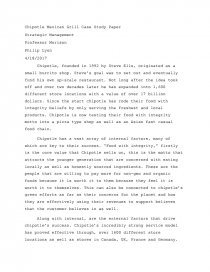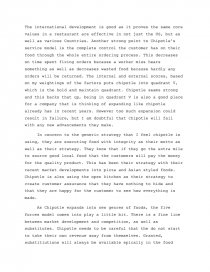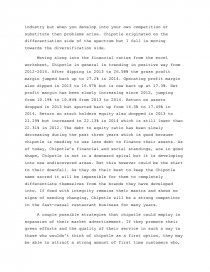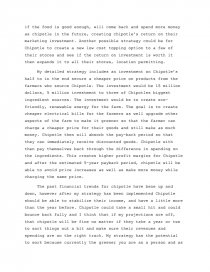Chipotle Case Study Summary
Essay by Phillycheese53 • May 2, 2017 • Business Plan • 1,500 Words (6 Pages) • 1,201 Views
Chipotle Mexican Grill Case Study Paper
Strategic Management
Professor Morison
Philip Lyon
4/18/2017
Chipotle, founded in 1992 by Steve Ells, originated as a small burrito shop. Steve’s goal was to set out and eventually fund his own up-scale restaurant. Not long after the idea took off and over two decades later he has expanded into 1,600 different store locations with a value of over 17 billion dollars. Since the start chipotle has rode their food with integrity beliefs by only serving the freshest and local products. Chipotle is now testing their food with integrity motto into a pizza type shop as well as an Asian fast casual food chain.
Chipotle has a vast array of internal factors, many of which are key to their success. “Food with integrity,” firstly is the core value that Chipotle sells on, this is the motto that attracts the younger generation that are concerned with eating locally as well as honestly sourced ingredients. These are the people that are willing to pay more for non-gmo and organic foods because it is worth it to them because they feel it is worth it to themselves. This can also be connected to chipotle’s green efforts as far as their concerns for the planet and how they are effectively using their revenues to support believes that the customer believes in as well.
Along with internal, are the external factors that drive chipotle’s success. Chipotle’s incredibly strong service model has proved effective through, over 1600 different store locations as well as stores in Canada, UK, France and Germany. The international development is good as it proves the same core values in a restaurant are effective in not just the US, but as well as various Countries. Another strong point to Chipotle’s service model is the complete control the customer has on their food through the whole entire ordering process. This decreases on time spent fixing orders because a worker miss hears something as well as decreases wasted food because hardly any orders will be returned. The internal and external scores, based on my weightings of the factors puts chipotle into quadrant V, which is the hold and maintain quadrant. Chipotle seams strong and this backs that up, being in quadrant V is also a good place for a company that is thinking of expanding like chipotle already has in recent years. However too much expansion could result in failure, but I am doubtful that chipotle will fail with any new advancements they make.
In concern to the generic strategy that I feel chipotle is using, they are executing food with integrity as their motto as well as their strategy. They know that if they go the extra mile to source good local food that the customers will pay the money for the quality product. This has been their strategy with their recent market developments into pizza and Asian styled foods. Chipotle is also using the open kitchen as their strategy to create customer assurance that they have nothing to hide and that they are happy for the customer to see how everything is made.
As Chipotle expands into new genres of foods, the five forces model comes into play a little bit. There is a fine line between market development and competition, as well as substitutes. Chipotle needs to be careful that the do not start to take their own revenue away from themselves. Granted, substitiutions will always be available epically in the food industry but when you develop into your own competition or substitute then problems arise. Chipotle originated on the differentiation side of the spectrum but I fell is moving towards the diversification side.
Moving along into the financial ratios from the excel worksheet, Chipotle in general is trending in positive way from 2012-2014. After dipping in 2013 to 26.58% the gross profit margin jumped back up to 27.2% in 2014. Operating profit margin also dipped in 2013 to 16.57% but is now back up at 17.3%. Net profit margin has been slowly increasing since 2012, jumping from 10.19% to 10.84% from 2013 to 2014. Return on assets dropped in 2013 but spurted back up from 16.3% to 17.49% in 2014. Return on stock holders equity also dropped in 2013 to 21.29% but increased to 22.13% in 2014 which is still lower than 22.31% in 2012. The debt to equity ratio has been slowly decreasing during the past three years which is good because chipotle is needing to use less debt to finance their assets. As of today, Chipotle’s financial and social standings, are in good shape, Chipotle is not in a downward spiral but it is developing into new undiscovered areas. But this however could be the start to their downfall. As they do their best to keep the Chipotle name sacred it will be impossible for them to completely differentiate themselves from the brands they have developed into. If food with integrity remains their mantra and shows no signs of needing changing, Chipotle will be a strong competitor in the fast-casual restaurant business for many years.
...
...




